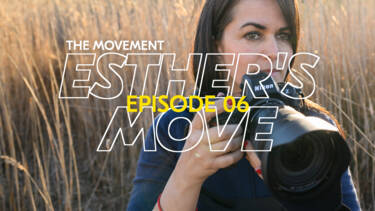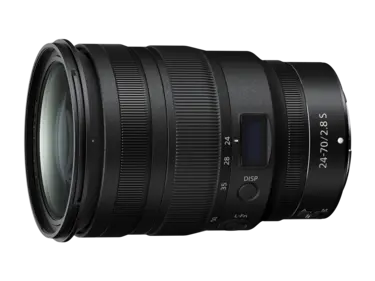Capturing the portrait moment with Esther Horvath

For science photographer Esther Horvath, shooting portraits is all about layers: the subject, their story and the environment. She sits down with Nikon magazine to discuss her approach to photographing polar regions, how she manipulates light, and the new Nikon Z 8
Esther Horvath holds up Rembrandt’s Cupid Blowing Soap Bubbles. The Baroque Dutch painter’s artwork is printed on a postcard, but it’s contrast with light and depiction of shadows still shines through. It is this postcard that Esther has with her when she travels on months long expeditions to the Arctic Ocean photographing polar regions — it acts as a constant reminder of how she wants the light in her images.
Esther is clearly a busy woman. She’s a documentary photographer, Fellow at the International League of Conservation Photographers, a science photographer for Alfred Wegener Institute and a Nikon Ambassador. Recently though, the 44-year-old switched sub-zero temperatures for sunny Spain to test out the new Nikon Z 8 as part of our The Movement series. Here she tells Nikon magazine her approach to portraiture, her motivation behind visual storytelling and why the new Z 8 is now her go-to camera.

You trained at the International Center of Photography in New York but when was the moment you realised you wanted to be a photographer?
In 2004, I got my very first camera, which was a Nikon COOLPIX and I realised that I could make my childhood dream come true: I could tell stories with a camera. I immediately fell in love with taking pictures. And with this new camera in my hand, I went to Egypt for a vacation – one week on a boat – and I did a mini documentary about the crew, and I then applied for a photo competition, and I won! It was such a big sign and a milestone in my life that immediately as I received this prize, I decided that yes, I wanted to become a photographer.

What story are you trying to tell through your photography?
I want to tell climate stories through the eyes of scientists. We know there’s scientific data, we know that the average temperature of the Arctic Ocean is increasing — but who are the scientists? Who are the people who dedicate their entire life to one scientific aspect?
The first time I went to the Arctic Ocean was 2015 for an assignment for an American magazine. I worked with scientists who research climate change and the changes of the Arctic Ocean ecosystem, and I fell in love so much with the scope that I decided that I wanted to continue doing this.
I’m most interested in female researchers as they are a minority which is why one of my main projects is called Women of Arctic Science – it’s a very personal collection of portraits highlighting those at work.
I want to show young girls and women that if you put your mind to something and work hard, you can reach your dreams. My Women of Arctic Science project is as much about putting female scientists front and centre as it is about inspiring the next generation.
I hope I can change people’s minds and change how they see the polar regions and nature. It’s not about taking pretty pictures during an expedition; it’s about communicating scientific research and findings.

Documentary photography with Esther Horvarth
Hit the play button to watch
Could you walk us through the process of shooting your portraits?
When I work with scientists, I photograph in two different ways. One is a photojournalistic approach, where I stay in the background, and I photograph their work and try to be invisible. If it's possible, I use flashlight but it's often difficult in the environment when we move a lot and when I'm without an assistant. But if we are stationed at a point, and if I go out with scientists who do snow measurements at one location for example, I will use flash. If it’s cold and dark but also if there is bright light outside, I will use off-camera flash. I love to use a light which creates a cinematic feeling against the blue light or darkness of the night — and it’s dark for five months in the Arctic! If there is sun, I will use a flashlight and in Spain because of the harshness of the sun, I used a soft box. If I’m photographing indoors, I will use flash and also continuous lights. Continuous lights are better for indoor shoots because of their battery, which can struggle in cold environments, and I use them often in low ambient light situations.
Light is clearly a massive factor in what you do. What advice would you give to those wanting to replicate your use of light?
Before I started the Women of Arctic Science, I was searching for concept a long time. The advice that I would give is to study light, and study styles and approach. Before starting a portrait series, have a concept to hand. It doesn’t have to include additional light — it could be use of sunlight or reflecting light in a certain way. And for me, before I took the very first image of the series, I already had the concept in my head — I knew Rembrandt’s use of light and shadows would act as my inspiration.

How does your current set up compare to the Z 8? What were your first impressions of the Z 8?
It was amazing. I use the Nikon D850 and I could not imagine that I would have something better in my hands than that, and then when I tried the Z 8 in Spain – I knew it was going to my new baby! It's very light and super easy to handle and I love how it’s silent, which is especially important when shooting in the Arctic, so I can remain invisible. It has a very good sensor for working in different lighting scenarios.
What does a strong portraiture mean to you?
A strong portraiture to me is where you spend time looking at a photograph because you find it so interesting, and it draws your attention. My series has a very strong concept that shows woman who work in polar science, it also shows something in her hands the majority of the time or wearing something on her which describes her work and herself, and she is placed in an environment which is connected to her work or to her story. The photograph always has several layers. It's not only about her but also about her environment, and her work.
There’s lots of planning and discussion between me and the scientist. We speak about the right location, what to wear, what to have in her hands and how to sit or stand. I want the message of each image to be strong.
You can explore Esther’s Women in Arctic Science series here.

Explore more of The Movement series
Discover the Nikon Z8

Unlock greater creativity









